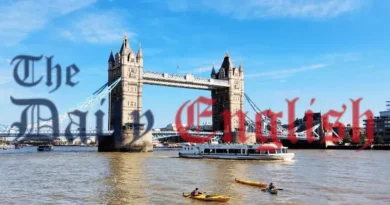How deep is the River Thames? Exposing the River Thames
The River Thames’ depth varies along its 215-mile stretch. On average, it reaches around 20 meters (66 feet) maximum, making it one of the deepest rivers in the United Kingdom. However, its depth can be much shallower in certain areas, like near London Bridge, where it’s only about 1.5 meters (5 feet) deep.
| Location | Upstream Depth (m) | Downstream Depth (m) |
|---|---|---|
| Whitchurch Lock | 0.11 | 2.01 |
| Mapledurham Lock | 0.06 | 2.25 |
| Reading | 6.73 | – |
| Caversham Lock | 0.16 | 1.68 |
| Sonning Lock | 0.11 | 2.02 |
| Shiplake Lock | 0.09 | 2.13 |
| Marlow Lock | 0.10 | 2.15 |
| Cookham Lock | 0.09 | 2.78 |
| Windsor Park | 3.35 | – |
Key Takeaways
| Section | Key Takeaways |
|---|---|
| Introduction | The depth of the River Thames significantly influences its ecosystem and human activities. |
| Geographical Overview | The Thames spans 215 miles, flowing through key regions like Oxford, Reading, and London. |
| Historical Changes in Depth | Depth changes over time due to sedimentation, flooding, and human interventions like dredging. |
| Current Depth Measurements | Depth varies, with the deepest points near London Bridge at 20 meters and shallow points upstream. |
| Factors Affecting Depth | Natural factors include sediment deposition, geological formations; and human activities like construction. |
| Depth by Region | Upper Thames is shallow, Middle Thames is deeper, and Lower Thames is the deepest due to management for shipping. |
| Depth Measurement Techniques | Modern techniques include echo sounding, satellite imagery, and Lidar for high accuracy. |
| Impact of Depth on River Usage | Depth affects navigation, flood control, and habitat diversity along the river. |
| Challenges in Maintaining Depth | Continuous sediment management and climate change pose challenges to maintaining depth. |
| Future Projections | Climate change and urbanization are expected to influence future depth variations. |
Let’s explore the details:
Introduction
The River Thames, a prominent feature in the landscape of southern England, has long been a subject of fascination and study. Its depth, a key characteristic, influences many aspects of life along its banks.
This article delves into the depths of the Thames, exploring historical changes, current measurements, factors affecting its depth, and regional variations.
Geographical Overview
General Description of the River’s Course
The River Thames flows through the heart of England, beginning in the Cotswold Hills and winding its way through major cities and rural areas before emptying into the North Sea.
Spanning approximately 215 miles, it is the longest river in England and the second longest in the United Kingdom. The river passes through notable locations such as Oxford, Reading, and London, playing a vital role in the regions it traverses.
Regions Through Which the River Flows
The Thames can be broadly divided into three sections: the Upper Thames, the Middle Thames, and the Lower Thames. Each section presents unique characteristics and challenges regarding its depth:
- Upper Thames: This stretch includes the river’s source and runs through rural landscapes. The river here is often narrow and shallow.
- Middle Thames: This central section flows through towns and cities, where the river widens and its depth increases.
- Lower Thames: The final section before the river meets the sea, where it becomes deeper and significantly wider, accommodating larger vessels.
Historical Changes in Depth

Historical Records and Changes Over Time
Historically, the depth of the River Thames has varied significantly. Ancient records, including those from Roman times, indicate that the river was crucial for transport and trade, necessitating frequent measurements and adjustments.
Medieval documents reveal that silting was a common issue, often reducing the river’s depth and hindering navigation.
Factors Contributing to Depth Changes Historically
Several factors have contributed to the historical changes in the Thames’ depth:
- Sedimentation: The natural process of sediment deposition has continuously altered the river’s depth.
- Flooding: Flood events have periodically reshaped the riverbed, affecting depth measurements.
- Human Intervention: Dredging and construction activities significantly modified the river’s depth, especially during the industrial era. Structures like locks and weirs were built to manage water levels and facilitate navigation.
Current Depth Measurements
Deepest Points Along the River
The most recent data shows that the deepest part of the River Thames is near London Bridge, where the depth reaches approximately 20 meters (66 feet). This depth accommodates large vessels, making the area a bustling hub for maritime activities.
Shallowest Points and Average Depth
In contrast, the shallowest sections are found near the river’s source in the Cotswolds, where the depth can be as little as 0.5 meters (1.6 feet). The average depth of the river varies but is generally around 4-5 meters (13-16 feet) in the middle sections.
Factors Affecting Depth
- Geological Formations: The riverbed’s geological makeup influences the depth. Areas with harder rock formations tend to be deeper.
- Sediment Deposition: Sediment from tributaries and runoff accumulates in the river, affecting depth. Periods of heavy rain can increase sediment load, temporarily altering depths.
- Erosion: Natural erosion processes also play a role, particularly in areas with softer geological substrates.
- Dredging: Regular dredging is conducted to maintain navigation channels, especially in the Lower Thames. This activity directly impacts the river’s depth, ensuring it remains suitable for commercial and recreational use.
- Construction: Building bridges, piers, and flood defences has modified the riverbed over time. Such constructions can cause local variations in depth.
- Water Extraction: Water extraction for agricultural, industrial, and domestic use can influence the river’s flow and, consequently, its depth.
Depth by Region

Depth variations along the River Thames are significant and closely tied to natural geography and human influence.
- Upper Thames: Characterized by its shallow depth, this section is primarily rural and less influenced by large-scale human activity.
- Middle Thames: As the river flows through more urban areas, its depth increases to support navigation and urban infrastructure.
- Lower Thames: This section, closer to the sea, is the deepest and heavily managed to support shipping and trade.
Depth Measurement Techniques
Historical Methods
In the past, depth measurement was rudimentary, relying on weighted lines and manual readings. Historical records often provide only approximate depths due to the limitations of these methods.
Modern Techniques
Today, advanced technologies are used to measure the depth of the River Thames:
- Echo Sounding: This technique uses sound waves to determine depth, providing accurate and real-time data.
- Satellite Imagery: Modern satellite technology can monitor changes in river depth and sediment movement.
- Lidar: Light Detection and Ranging (Lidar) offers high-resolution depth maps, crucial for detailed analysis and planning.
Which notable bridges are on the River Thames?
Here is a list of bridges that span the River Thames:
- Tower Bridge
- London Bridge
- Westminster Bridge
- Waterloo Bridge
- Blackfriars Bridge
- Southwark Bridge
- Millennium Bridge
- Chelsea Bridge
- Albert Bridge
- Battersea Bridge
- Vauxhall Bridge
- Lambeth Bridge
- Chiswick Bridge
- Hammersmith Bridge
- Barnes Bridge
- Richmond Bridge
- Kingston Bridge
- Hampton Court Bridge
- Walton Bridge
- Shepperton Bridge
Please note that this list includes some notable bridges along the River Thames. Still, there may be additional smaller bridges as well.
Impact of Depth on River Usage
Navigation and Transportation
The depth of the Thames is crucial for navigation, especially in the lower sections where large vessels operate. Regular maintenance ensures the river remains navigable for commercial shipping and vital for trade and economic activities.
Flood Control and Management
Depth plays a significant role in flood management. Maintaining an optimal depth helps manage water flow and reduces the risk of flooding, particularly in urban areas where the impact can be severe.
Ecosystem and Habitat Implications
The river’s depth affects its ecosystem, influencing the habitats available for aquatic life. Varied depths support diverse species, contributing to the river’s ecological health.
Challenges in Maintaining Depth
Environmental Challenges
Sediment management is a continuous challenge, with natural processes constantly altering the riverbed. Climate change poses additional risks, potentially increasing the frequency of extreme weather events that affect sediment flow and deposition.
Technological and Logistical Challenges
Maintaining the depth of the River Thames requires significant technological and logistical efforts. Dredging operations are costly and must be carefully planned to minimize environmental impact while ensuring navigability.
Future Projections
Predicted Changes in the River’s Depth
Future projections suggest that the depth of the Thames will continue to be influenced by both natural and human factors. Climate change, in particular, is expected to bring more frequent and severe weather patterns, impacting sediment deposition and erosion processes.
Impact of Climate Change and Urbanization
Urbanization along the Thames’ banks will likely increase, necessitating further modifications to manage depth and flow. Climate change may lead to rising sea levels, affecting the river’s depth, especially in the lower sections near the estuary.
Conclusion
Understanding the depth of the River Thames is crucial for managing its many uses, from navigation and flood control to ecological health.
Ongoing research and monitoring are essential to adapt to changing conditions and ensure the river continues to serve the needs of those who depend on it.
FAQ
What is the average depth of the River Thames?
The average depth of the River Thames is approximately 7.5 metres (24.6 feet) along its tidal sections. However, upstream of Teddington Lock, where the river is non-tidal, the average depth reduces to about 2 metres (6.5 feet), depending on location and water flow.
How deep and wide is the River Thames in London?
The depth of the River Thames in London varies significantly due to tidal conditions and dredging activities. On average, the depth ranges from around 5 meters (16 feet) to 9 meters (30 feet) in central London. The width of the Thames also varies, with an average width of approximately 300 meters in central areas.
What is the deepest point of the River Thames?
The deepest point of the River Thames is near Woolwich in southeast London, where the depth reaches approximately 23 meters (75 feet). This area is known as Woolwich Reach and has a deep underwater channel accommodating large vessels.
Does the River Thames freeze in winter?
The River Thames has frozen in the past, but it is rare for it to freeze completely in modern times. Increased urbanization, river flow, and tidal nature have made it less susceptible to freezing. Historical records indicate significant freezes in the 17th and 18th centuries, but current conditions and climate changes prevent such events today.
How does the depth of the River Thames affect wildlife?
The depth of the River Thames is crucial for various wildlife species. Deeper sections provide suitable habitats for larger fish, while shallower areas support a diverse range of invertebrates and smaller fish. The depth impacts oxygen levels and nutrient availability, which are vital for the river’s ecosystem health.
What measures are taken to manage flood risk along the River Thames?
Flood management measures along the River Thames include constructing flood barriers, dams, and floodplain areas. Advanced flood forecasting systems and continuous monitoring help authorities anticipate and respond to flood threats effectively.
Are there any regulations for vessels navigating the River Thames?
Yes, regulations govern vessel traffic on the River Thames, including speed limits, clearance heights, and requirements for navigational aids. These regulations ensure safe and efficient navigation for all river users.
How deep is the River Thames at Tower Bridge?
The depth of the River Thames at Tower Bridge varies with the tide, ranging from around 1.5 meters at low tide to over 6 meters at high tide. This variation is due to the tidal influence, which causes significant changes in water levels throughout the day.
What is the deepest part of the River Thames?
The deepest part of the River Thames is near the London Bridge area, where the riverbed reaches a depth of 20 metres (66 feet). This depth accommodates heavy commercial traffic, including large vessels navigating the busy tidal stretch of the Thames.
How deep is the Thames at high tide?
At high tide, the depth in the tidal Thames can increase by as much as 7 metres (23 feet), depending on the tidal range. In Central London, this means depths can reach up to 15 metres (49 feet), particularly near bridges like Tower Bridge.
How shallow is the Thames at low tide?
At low tide, the riverbed is exposed in some areas, reducing the depth significantly. In sections such as Richmond and upstream tidal zones, depths can drop to around 1 metre (3.3 feet) or less, revealing mudflats and sandbanks.
What affects the depth of the River Thames?
The depth of the Thames is influenced by several factors, including tidal cycles, sedimentation, man-made structures like locks and weirs, and seasonal water flow. Human interventions, such as dredging, ensure navigation in critical areas like the estuary and ports.
How deep is the River Thames in Central London?
In Central London, the River Thames has a depth that ranges between 6 and 15 metres (20 to 49 feet), depending on the tidal conditions. Notable areas like Westminster, Southwark, and the Docklands are maintained for shipping and river traffic.
Is the River Thames deeper near its mouth?
Yes, the Thames Estuary near its mouth is deeper, with depths ranging from 8 to 20 metres (26 to 66 feet). This depth supports large commercial shipping vessels entering and leaving the Port of London, one of the busiest ports in the UK.
What is the depth of the River Thames at Teddington Lock?
At Teddington Lock, the last lock before the tidal Thames, the depth averages around 3 to 5 metres (10 to 16 feet). Downstream, the river becomes tidal, while the depth gradually decreases into the non-tidal sections upstream.
How deep is the River Thames at Oxford?
In Oxford, where the Thames is often called the “Isis,” the depth averages between 1.5 and 2.5 metres (5 to 8 feet). The shallow waters here are ideal for rowing and punting, with deeper stretches found in the weir pools.
What is the minimum depth of the River Thames for navigation?
The River Thames is maintained at a minimum navigable depth of 3.2 metres (10.5 feet) in the tidal sections. This depth ensures that both commercial and recreational vessels can traverse the river safely, even at low tide.
How does dredging affect the depth of the Thames?
Dredging is essential to maintain navigable depths, particularly in areas like the Thames Estuary and Docklands. It removes sediment build-up obstructing shipping lanes, ensuring safe passage for large vessels and preventing flooding in urban areas.
What is the depth of the Thames near Henley?
At Henley-on-Thames, famous for the Henley Royal Regatta, the river depth averages 2 to 3 metres (6.5 to 10 feet). The stretch is carefully maintained for rowing events, with shallower sections along the banks and deeper channels in the middle.
How does the tide affect the depth of the Thames?
The tide significantly affects the Thames, with tidal ranges varying between 4 and 7 metres (13 to 23 feet) in London. This variation creates a dynamic flow, exposing mudflats at low tide and deepening channels at high tide, particularly in the tidal reaches downstream of Teddington.
What is the depth of the River Thames during floods?
The Thames can rise several metres during floods, particularly in low-lying areas. Flood defences, such as the Thames Barrier, prevent surges that could increase depths beyond navigable levels and inundate nearby areas.
Is the River Thames shallower upstream?
Yes, upstream of Teddington Lock, the non-tidal Thames becomes significantly shallower, with depths averaging between 0.5 and 2 metres (1.6 to 6.5 feet). This section is more influenced by natural flow and less by tidal fluctuations.
What is the depth of the Thames near Canary Wharf?
At Canary Wharf, the depth of the Thames ranges between 8 and 14 metres (26 to 46 feet). This area is crucial for shipping and features deeper channels to accommodate large vessels serving London’s commercial hubs.
How deep is the Thames Barrier area?
The Thames Barrier area in Woolwich has a depth ranging from 10 to 16 metres (33 to 52 feet). This depth ensures the effective operation of the barrier, which protects Greater London from tidal flooding during high-risk events.
What is the depth of the Thames near Reading?
In Reading, the River Thames has a depth that averages 2 to 3 metres (6.5 to 10 feet). Deeper areas are found around the lock systems, while the rest of the river is shallow, suitable for leisure activities like boating and fishing.
What is the effect of sediment on Thames depth?
Sediment accumulation reduces the depth of the Thames in certain sections, particularly in the estuary and tidal zones. This sedimentation requires regular dredging to maintain navigability and prevent shipping and flood control disruptions.
What is the depth of the Thames at Richmond Lock?
At Richmond Lock, the depth varies from 3 to 6 metres (10 to 20 feet), depending on tidal flow and the operation of the sluice gates. This lock helps regulate water levels upstream and ensures consistent depths for navigation and leisure activities.










Comments are closed.